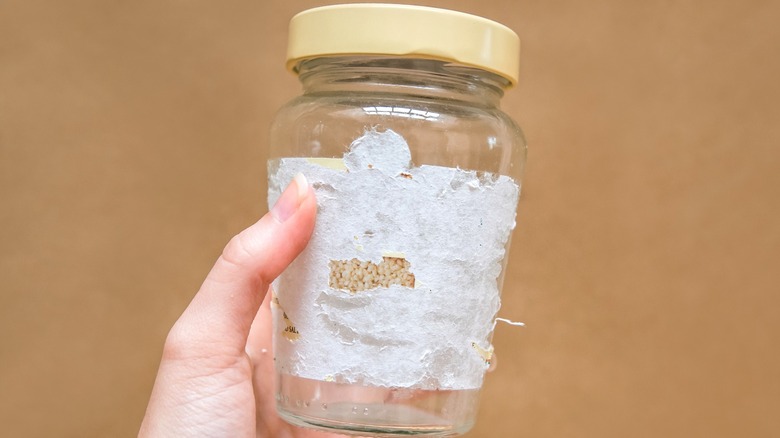Easily Remove Labels From Glass Jars For All Your Projects With DIY Goo Gone
You've finally found some clever ways to reuse those old glass jars around the house, and you're so happy about it. However, you're now faced with another dilemma — peeling off the old labels to reuse them, a mundane task that can make anyone question their life choices. You search the area beneath your kitchen sink only to find that the Goo Gone is completely, well ... gone. But don't fret! There is a quick hack you can try to make your own Goo Gone in no time. And you'll be happy to know all the ingredients you need may be in your kitchen already. For this DIY, all you'll need are olive oil and baking soda. So, before you risk injury by taking a razor to the jars, consider this method instead. It's inexpensive, fast, and absolutely effective.
How, exactly, does this method work, you ask? Simple. This easy DIY hack makes quick work of sticky labels because the olive oil breaks down the adhesive components, making it easier to slide off the jar. The baking soda (sodium carbonate) essentially works like a scrub pad to gently remove the broken-down glue and paper from the smooth glass surface without damaging it. Expect to spend about $10 for this project if you don't already have these ingredients at home. There are no harsh chemicals to touch and no toxic fumes to avoid, just an affordable and quick solution.
How to create DIY Goo Gone for glass jar labels
This hack will definitely come in handy if you are big on using labels and stickers to keep a perfectly organized kitchen or have found numerous ways to use your new label maker around your house. Start by removing as much of the label as possible from your jar. If you aren't able to remove it without it peeling, toss the jar in hot water, and let it soak for a few seconds to help soften the adhesive and paper. When doing so, be sure to grab a pair of tongs to handle the jar to avoid injury. Allow the jar to cool before handling it again.
Next, add one part baking soda and one part olive oil to a cup. The amount can vary depending on the number of jars you're cleaning. Using a spoon, stir the ingredients together until the solution becomes a semi-runny paste. Once it's mixed, grab a spoonful to apply on the jar, covering the areas that have adhesive.
Allow the solution to sit on the jar for 5 to 10 minutes or longer as needed (be sure to set the jar on top of a pan or napkin). Afterward, wipe off the solution and any remaining paper or residue. For this, you can use your nails or handy items like a butter knife, popsicle stick, or damp microfiber cloth. If you happen to be low on olive oil, you can also swap it out for baby oil or coconut oil.
